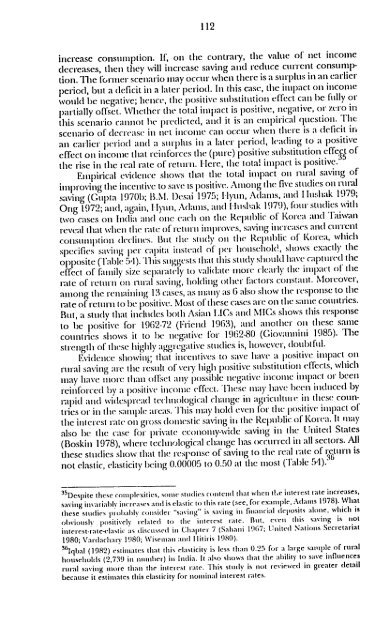I Fiance Apicultural
I Fiance Apicultural
I Fiance Apicultural
Create successful ePaper yourself
Turn your PDF publications into a flip-book with our unique Google optimized e-Paper software.
112<br />
increase consumption. If, on the contrary, the value of net income<br />
decreases, then they will increase saving and reduce current consumption.<br />
The former scenario may occur when there is a surplus in an earlier<br />
period, but a deficit in a later period. In this case, the impact on income<br />
would be negative; hence, the positive substitution effect can be fully or<br />
partially offset. Whether the total impact is positive, negative, or zero in<br />
this sccnario cannot he predicted, and it is an eml)irical question. The<br />
scenario of decrease in net income c-an occur when there is a deficit ir<br />
an carlier period and a strphls in a later period, leading to a positive<br />
effect on income that reinforces the (pure) positive substitution effect 35 of<br />
1lere, the total impact is positive.<br />
the rise in the real rate of return.<br />
Empirical evidence shows that the total impact on rural saving of<br />
improving the incentive to save is positive. Among the five studies on rural<br />
saving (Gupta 19701; B.M. l)esai 1975; 1ytn, Adains, and I lIshak 1979;<br />
Ong 1972; and, ag-ain, I-lyun, Adams, and I-uslak 1979), four studies with<br />
two cases on India and ow each on tie Republic of Korea and Taiwan<br />
reveal that wheni the rt e of return initloves, saving increases and current<br />
colstumption declines. But tlie study on the Republic of Korea, which<br />
specifies saving per capita inistead of per hotsehold, shows exactly the<br />
opposite (Table 5,t). 'liis suggests that this study should have captured the<br />
effect of famtily size separately to validate more clearly the impact of the<br />
rate of return on rtual saving, holding other factors coaistaiit. Moreover,<br />
among the remaining 13 cases, as tiany as 6 also show the response to the<br />
rate of retutrn to be positive. Most of these cases are on the sale countries.<br />
But, a study that includes both Asian lICs and MICs shows this response<br />
to be positive for 1962-72 (Friend 1963), and another oii these same<br />
countries shows it to be negative for 1962-8(0 (Giovantini 1985). The<br />
strength of these highly aggregative studies is, however, doubtfil.<br />
Evidence showing that incentives to save have a positive impact On<br />
rurai saving are flie mresult of very high positive substitution effects, which<br />
may have nore thali oflset any possible negative income impact or been<br />
reinforced by a positive iltcome effect. These ,may have been induced by<br />
rapid and widespread technological chtange in agrictilti Ie in Iese conun<br />
1lhis Ilty hold even for tle positive impact of<br />
tries or il the smtplhe areas.<br />
the interest rate on gross domestic saving in the Republic of Korea. It may<br />
also be tie case for private econoliy-wide saving in the United States<br />
(Boskin 1978), where technological change has occurred iti all sectors. All<br />
these stuldies show that the response of saving to the real rate of return is<br />
not elastic, elasticity being 0.00005 to 0.50 at the most (Table 5'I).' 6<br />
i terest ,ate increases,<br />
35Despite these cotuplexities, soite sitdies contenIti thai when Ie<br />
saving invariably increases and is clastic to this rate (see, for example, Adams 1978). What<br />
Itiese studies plolablv conlsider "saving" is saving in financial deposits alone, which is<br />
rae. But. evell this saving is ,1ot<br />
obtviouisly positively related toI e iicnterest<br />
United Nations Secretariat<br />
interest-lateciastic as discussed ill Chapter 7 (Sahani 1967;<br />
1980; Vardachary 1980; Wisenan and t tiliris 1980).<br />
36<br />
tqbat (1982) estimates that tins elasticity is less than 0.25 for a targe sample of rural<br />
ber) ill India. It also shows that the ability to save influences<br />
households (2,739 itn nm<br />
i lerst rate. This study is not reviewed in greater detail<br />
rut ral saving Itore tha lhe<br />
because it estimates this elasticity for nominal intteest rates.

















